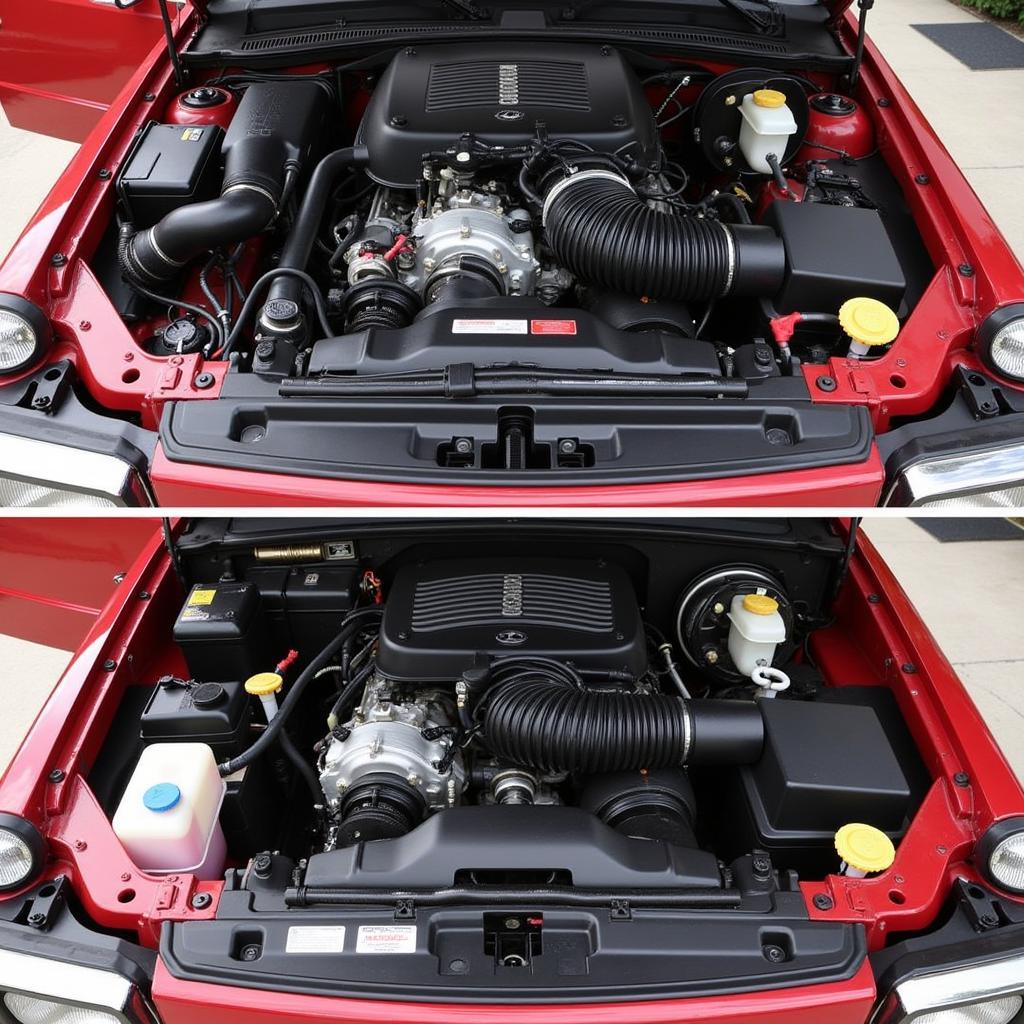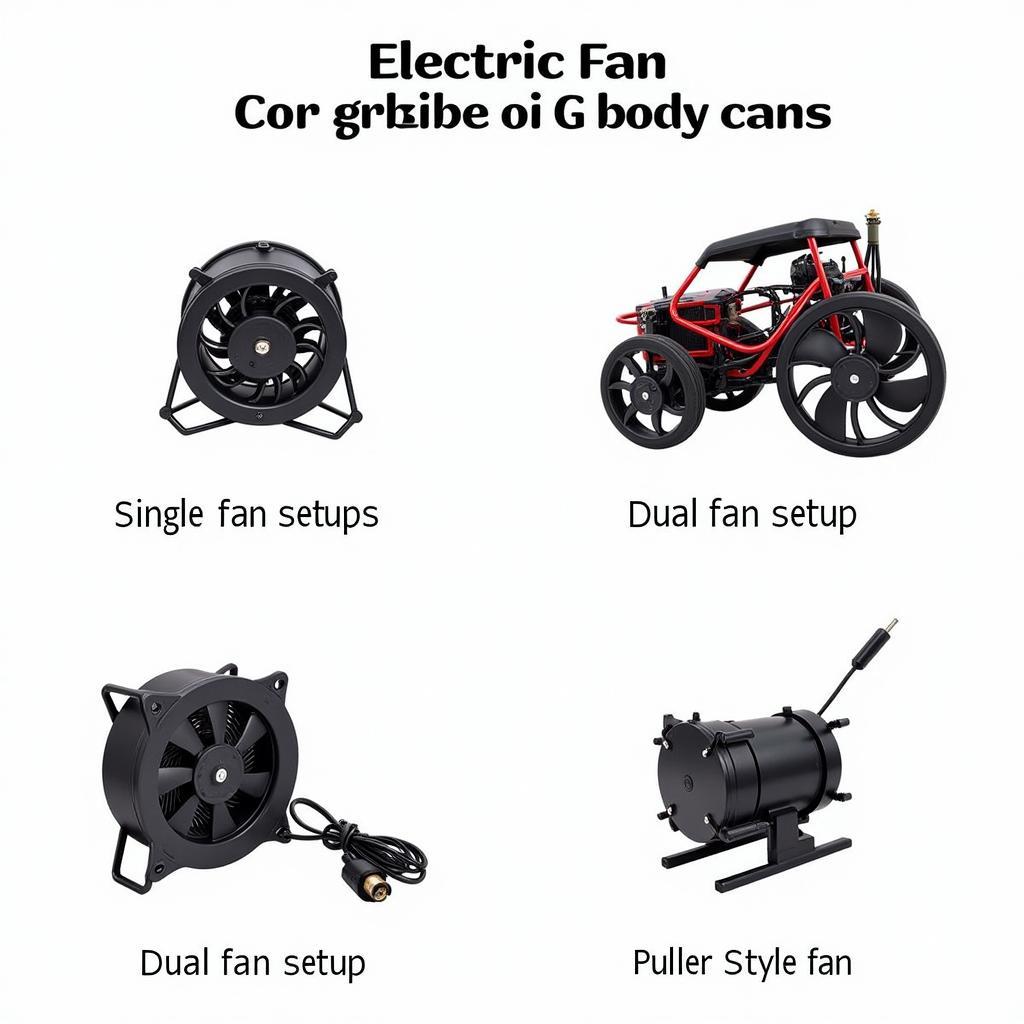G Body Electric Fans: The Ultimate Guide to Keeping Your Classic Cool
October 10, 2024G body cars, produced by General Motors from 1978 to 1988, are renowned for their style, performance, and affordability. However, like many classic cars, they can struggle with overheating, especially during hot weather or spirited driving. That’s where G Body Electric Fans come in, offering a modern solution to a classic problem. These fans provide superior cooling compared to their mechanical counterparts, leading to improved engine performance, fuel efficiency, and longevity.
Why Ditch Your Mechanical Fan?
Traditional mechanical fans, while reliable, have inherent drawbacks. They constantly sap engine power, even when cooling isn’t critical. This parasitic loss translates to reduced horsepower and decreased fuel economy. G body electric fans, on the other hand, operate only when needed, freeing up valuable horsepower and improving your car’s efficiency.
 G Body Engine Bay Comparison
G Body Engine Bay Comparison
Benefits of Upgrading to Electric Fans
The advantages of g body electric fans extend beyond just improved cooling. Here’s a closer look at the key benefits:
- Enhanced Engine Performance: By reducing the load on your engine, electric fans unlock hidden horsepower and improve throttle response.
- Increased Fuel Efficiency: Electric fans draw less power than mechanical fans, resulting in noticeable fuel savings over time.
- Reduced Engine Wear: Consistent cooling provided by electric fans helps prevent overheating, extending engine life and reducing the risk of costly repairs.
- Customizable Cooling: Electric fans offer adjustable thermostats and multi-speed controls for tailored cooling based on your driving conditions.
- Quieter Operation: Electric fans are significantly quieter than mechanical fans, providing a more enjoyable driving experience.
Choosing the Right G Body Electric Fan
Selecting the right electric fan for your g body involves considering several factors:
- Radiator Size: The size of your radiator dictates the airflow needed for optimal cooling.
- Engine Size and Power: High-performance engines generate more heat, requiring fans with higher CFM (cubic feet per minute) ratings.
- Available Space: Engine bay space varies between g body models, impacting the size and type of fan that can be accommodated.
 Types of G Body Electric Fans
Types of G Body Electric Fans
Installation Tips for a Seamless Upgrade
While professional installation is recommended, many g body enthusiasts choose the DIY route. Here are some tips for a successful installation:
- Disconnect the Battery: Always disconnect the negative battery terminal before starting any electrical work.
- Remove the Mechanical Fan: Carefully remove the existing mechanical fan, shroud, and any related components.
- Mount the Electric Fan: Securely mount the electric fan to the radiator using the provided brackets or a custom mounting solution.
- Wire the Fan: Connect the fan wiring to your vehicle’s electrical system, ensuring proper grounding and using relays if necessary.
- Test the System: After installation, thoroughly test the fan’s operation across various driving conditions to confirm proper cooling.
G Body Electric Fans: A Wise Investment
Upgrading to g body electric fans is a wise investment for any enthusiast looking to improve their classic car’s performance, efficiency, and longevity. With numerous options available, consult with fellow g body owners or automotive professionals to find the perfect fan for your specific needs and driving style.
Frequently Asked Questions (FAQs)
Q: Will an electric fan void my car’s warranty?
A: Installing an electric fan itself will not void your car’s warranty. However, if the installation is done improperly and causes damage, it may affect your warranty coverage.
Q: How long do g body electric fans typically last?
A: With proper installation and maintenance, g body electric fans can last for several years.
Q: Can I install an electric fan myself, or should I seek professional help?
A: While some enthusiasts successfully install their own electric fans, it’s recommended to seek professional installation, especially if you lack experience with automotive electrical systems.
Q: What are the signs of a failing electric fan?
A: Common signs include the fan not turning on, making unusual noises, or running constantly even when the engine is cool.
Q: How often should I check my electric fan?
A: It’s good practice to visually inspect your electric fan for any signs of damage or wear during routine maintenance checks.
Need Help?
For expert advice and assistance on selecting and installing the perfect g body electric fan for your classic car, contact us today at 0963418788, email us at [email protected], or visit us at 2M4H+PMH, Phường Nghĩa Thành, Gia Nghĩa, Đắk Nông, Việt Nam. Our dedicated team is available 24/7 to answer your questions and help you keep your classic running cool!